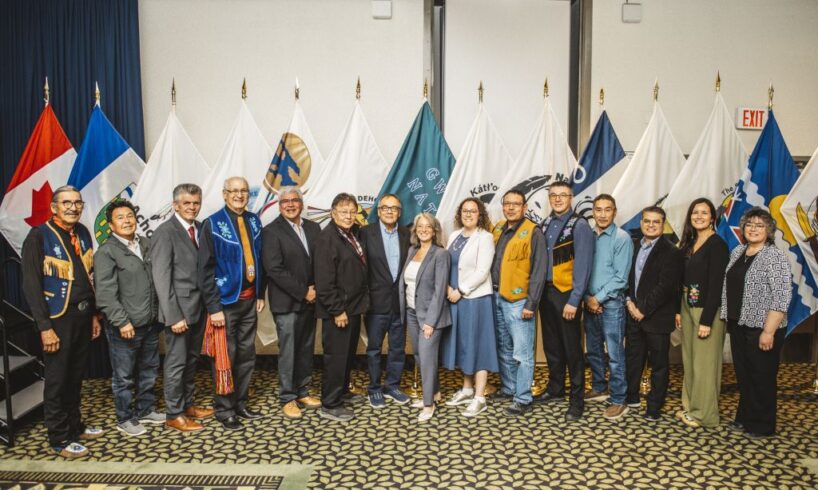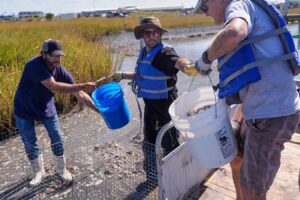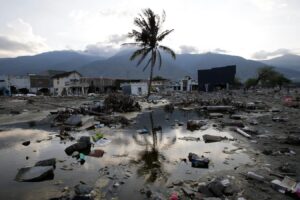
Federal, territorial and Indigenous leaders gathered in Yellowknife this morning to launch a landmark Indigenous-led conservation agreement that will protect nearly 380,000 square kilometres of land and water.
Following a prayer song by the Yellowknife Dene Drummers, Chief Ernest Betsina of the Yellowknives Dene First Nation opened the event, saying, “This document we signed today has been a long time in the making. It reflects years of collaboration and commitment from Indigenous leaders across the North. It reflects our shared understanding that Indigenous people have always been the stewards of the land. And it’s time for that responsibility to be recognized and supported.”
The Yellowknife Dene Drummers opened the event with a prayer song. Photo: Supplied by Angela Gzowski / Indigenous Leadership Initiative
The agreement, known as NWT: Our Land for the Future, is a partnership between the federal government, territorial government and 21 Indigenous governments across the Northwest Territories. It covers existing protected areas, which will share in the long-term funding, and around 200,000 square kilometres of new protected and conserved areas — forming a region roughly twice the size of Florida.
In addition to the $300 million in federal funding, the agreement also includes $75 million from philanthropic partners. In the next several months, the NWT: Our Land for the Future Trust will begin to distribute funds to Indigenous governments in the territory, to support activities such as conservation and stewardship, protected and conserved areas, Guardian programs, ecotourism and more.
Ɂek’wahtı̨dǝ́ (highest honest leader) Danny Gaudet of the Délın̨ę Got’ın̨ę Government said in November the funds will strengthen Northern cultures and create economic opportunities, enabling Indigenous nations to honour their responsibilities to their lands. Photos: Pat Kane / The Narwhal
Echoing statements from several chiefs, territorial Minister of Environment and Climate Change Jay MacDonald said, “This agreement represents a generational investment. It will provide opportunities to support Indigenous-led stewardship, while offering real, meaningful and new opportunities to Northerners, particularly in the small communities. We are seeing a shift toward a conservation economy that puts people, community and cultural values at the centre of decision-making.”
Minister of Environment and Climate Change Canada Julie Dabrusin echoed that sentiment. “This isn’t just a conservation announcement — it’s really a global milestone. Our Land for the Future is one of the largest Indigenous-led conservation efforts in the world. The areas that it is going to help to conserve is almost seven times the size of Nova Scotia,” she said, adding that represents more than two per cent of Canada’s land-mass.
Last November, the landmark agreement was signed in Behchokǫ̀, NWT, by leaders of Indigenous governments and organizations from across the territory at a celebration that also involved jigging, drum dancing and a fire-feeding ceremony, drawing community members of all ages.
Dahti Tsetso, the deputy director of the Indigenous Leadership Initiative and CEO of NWT: Our Land for the Future Trust, told The Narwhal in November the funds “have so much transformative potential.” In addition to generating hundreds of jobs each year, they can also support cultural and land-based programming, and create opportunities and positive examples for youth. This morning, she celebrated the “incredible milestone that so many people … put in an incredible amount of effort to get to this day.”
“It’s not just about the hectares, it’s really about the people,” Dahti Tsetso, CEO of NWT: Our Land for the Future Trust, told The Narwhal in November. Prior to the signing on Monday, she and Danny Yakeleya, Chair of the Our Land for the Future, shared stories with Julie Dabrusin, Minister of Environment and Climate Change Canada. Photo: Supplied by Angela Gzowski / Indigenous Leadership Initiative
The framework for the NWT: Our Land for the Future agreement was hatched on Wall Street. Called the project finance for permanence (PFP) model, it requires partners from private and public sectors to release money upfront in order to fund the comprehensive activities of a long-term project, laying the groundwork for stability and success.
As Dehcho First Nations Grand Chief Herb Norwegian put it in November, “We are going to create something totally beautiful, something totally unique.”
Updated July 21, 2025, at 2:11 p.m. PT: This article was updated to correct a typo in the spelling of territorial Minister of Environment and Climate Change Jay MacDonald‘s name.





